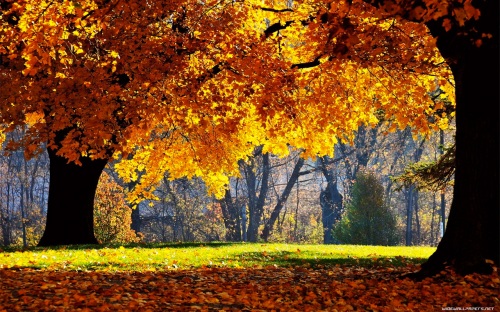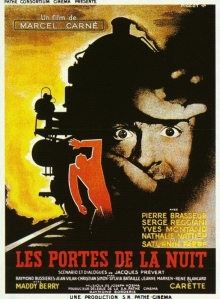
The Beatles’ 1965 song Yesterday may be the most recorded song according to The Guinness World Records, but Autumn Leaves has to rank up there pretty high, as evidenced by the number of recordings in this post. And these recordings are just the tip of the proverbial iceberg.
Originally, Autumn Leaves was a 1945 French song entitled Les Feuilles Mortes (literally “The Dead Leaves”) with music by Hungarian-French composer Joseph Kosma and lyrics by French surrealist poet Jacques Prévert. The Hungarian title is Hulló levelek (“Falling Leaves”).
The Italian born, French singing idol Yves Montand introduced the song in the 1946 film Les Portes de la Nuit, a gloomy urban drama set in post World War II Paris. Scriptwriter and poet Jacques Prevért and director Marcel Carné had been responsible for a string of films spawning the French “poetic realism,” a genre upon that the American film noir movement was based. Although Les Portes de la Nuit was a commercial failure, it fared much better when released in the United States several years later under the title Gates of the Night.
As the 1940’s waned, so too did the public’s appetite for the Tin Pan Alley style ballad. With decreasing demand for his sophisticated talents, lyricist Johnny Mercer found himself penning words for instrumentals. In the case of Les Feuilles Mortes, Mercer would not have thought twice about renaming what was literally “The Dead Leaves” to “Autumn Leaves.” “The Dead Leaves” may have been an appropriate song title for the somber Les Portes de la Nuit, but it would not do for an American popular song.
Initially the public showed little interest in Autumn Leaves. Jo Stafford was among the first to perform the Mercer version. Autumn Leaves became a pop standard and a jazz standard in both in French and English, both as an instrumental and as a vocal number. There is also a Japanese version called Kareha sung by none other than Nat “King” Cole!
On December 24, 1950, French singer Edith Piaf sang both French and English versions of the song on the radio program The Big Show, hosted by Tallulah Bankhead. The Melachrino Strings recorded an instrumental version of the song in London in August, 1950.
In 1955, however, all that changed. Pianist Roger Williams recorded a million-seller, number-one hit rendition of the song that stayed on the Billboard charts for six months. Williams’ recording is the only piano instrumental to ever reach the number one position on the Billboard chart. Williams’ success opened the door for a second spate of covers by Steve Allen, Mitch Miller, Jackie Gleason, Victor Young, and the Ray Charles Singers. All of these versions charted on Billboard’s chart. These covers would be followed by hundreds of renditions in subsequent decades.
In 1956, Columbia Pictures produced a film entitled Autumn Leaves starring Joan Crawford and Cliff Robertson. It is a generally well-reviewed tale of a spinster marrying a young man who has mental problems as a result of his ex-wife’s (Vera Miles) affair with his father (Lorne Green). Nat King Cole once again sang the song (this time in English) during the credits.
Frank Sinatra included a version of the song on his 1956 album Where Are You? Andy Williams released a version of the song on his 1959 album, Lonely Street. Raquel Bitton recorded a version in 2000 that appears on her album Raquel Bitton sings Edith Piaf. Jerry Lee Lewis released a version that is a real surprise. This version is from the unissued Caribou sessions from 1980, produced by Eddie Kilroy while Jerry Lee Lewis was with Elektra. Around forty tracks were taped at the Caribou ranch in Colorado in November and overdubs were made in 1981 and 1982, but no tracks were officially released. Listen to it and see what I mean.
In 1962, Serge Gainsbourg wrote a song entitled La Chanson de Prevert. This is a song about a song, for it is about Les Feuilles Mortes and how its power to revive memories kept dead loves alive. References to Verlaine’s Chanson d’Automne hint at its relation to classical French literature.
Greek-Cypriot recording artist Alexia Vassiliou recorded the song for her first 1996 album, In a Jazz Mood. The song also appears on Iggy Pop’s 2009 album Préliminaires as the opening track. A version by Eva Cassidy is one of the highlights of her seminal live album Live at Blues Alley (1996). The Electronic duo Coldcut recorded a cover of the song for their 1993 album Philosophy, featuring guest vocalist Janis Alexander on vocals.
And finally in the Pop field, British blues/rock guitarist Eric Clapton recorded a cover of Autumn Leaves in 2010.
In the jazz genre, this tune took almost ten years to catch on as a jazz number, and 1957 saw three excellent recordings. There were versions by Coleman Hawkins, Dizzy Gillespie and Duke Ellington.
The Ellington version, taken at a very slow tempo, and featuring Ray Nance on violin is a delight. Nance’s violin playing represented almost the total opposite of his trumpet playing, and he is at his soulful best on Autumn Leaves, where he plays an exquisite, emotional solo; he then fills along with vocalist Ozzie Bailey. The album, Ellington Indigos, offered a different, more sentimental side of the Ellington ensemble and has rarely been out-of-print since it was released.
Singer/pianist Patricia Barber mesmerizes with her version of Autumn Leaves. With her rendition, the song is refurbished with a torch singer’s touch.
The 1958 Cannonball Adderley recording of Autumn Leaves has inspired generations of jazz players. The arrangement, commonly credited to Miles Davis (who is also featured on trumpet here) actually comes mostly from Ahmad Jamal. Nonetheless, this is a recording that really caught on. The following year, Bill Evans made his recorded debut with his groundbreaking trio alongside bassist Scott LaFaro and drummer Paul Motian. Their version of Autumn Leaves is comparably influential to the Adderley version and offers an essential look at the interplay of these three musicians.
Finally, Autumn Leaves has been included in at least these films: Les Portes de la Nuit (1946, Yves Montand), Autumn Leaves (1956, Nat King Cole), Hey Boy! Hey Girl! (1959, Keely Smith), Addicted to Love (1997, Stephane Grappelli), Midnight In The Garden Of Good And Evil (1997, Paula Cole), and Sidewalks of New York (2001, Stan Getz)
LYRICS
Autumn Leaves [Les Feuilles Mortes]
Music: Joseph Kosma
French Lyrics: Jacques Prévert
English Lyrics: Johnny Mercer
The falling leaves drift by the window
The autumn leaves of red and gold
I see your lips, the summer kisses
The sun-burned hands I used to hold
Since you went away the days grow long
And soon I’ll hear old winter’s song
But I miss you most of all my darling
When autumn leaves start to fall
C’est une chanson, qui nous ressemble
Toi tu m’aimais et je t’aimais
Nous vivions tous, les deux ensemble
Toi que m’aimais moi qui t’aimais
Mais la vie sépare ceux qui s’aiment
Tout doucement sans faire de bruit
Et la mer efface sur le sable les pas des amants désunis
THE RECORDINGS
1. CHARTED VERSIONS [1955]
Roger Williams
Steve Allen/George Gates
Mitch Miller
Jackie Gleason
Victor Young
Ray Charles Singers
2. OTHER RECORDINGS
Jo Stafford
Nat King Cole [Japanese Version]
Edith Piaf
The Melachrino Strings
Serge Gainsbourg: La Chanson de Prévert
Frank Sinatra
Andy Williams
Raquel Bitton
Jerry Lee Lewis
Alexia Vassiliou
Iggy Pop
Eva Cassidy
Coldcut [Janis Alexander, vocals]
Eric Clapton
3. JAZZ VERSIONS
Cannonball Adderley
Bill Evans Trio
Coleman Hawkins
Dizzy Gillespie
Duke Ellington
Patricia Barber
4. MOVIE VERSIONS
Yves Montand Les Portes de la Nuit (1946)
Nat King Cole Autumn Leaves (1956)
Keely Smith Hey Boy! Hey Girl! (1959)
Stephane Grappelli Addicted to Love (1997)
Paula Cole Midnight In The Garden Of Good And Evil (1997)
Stan Getz Sidewalks of New York (2001)






